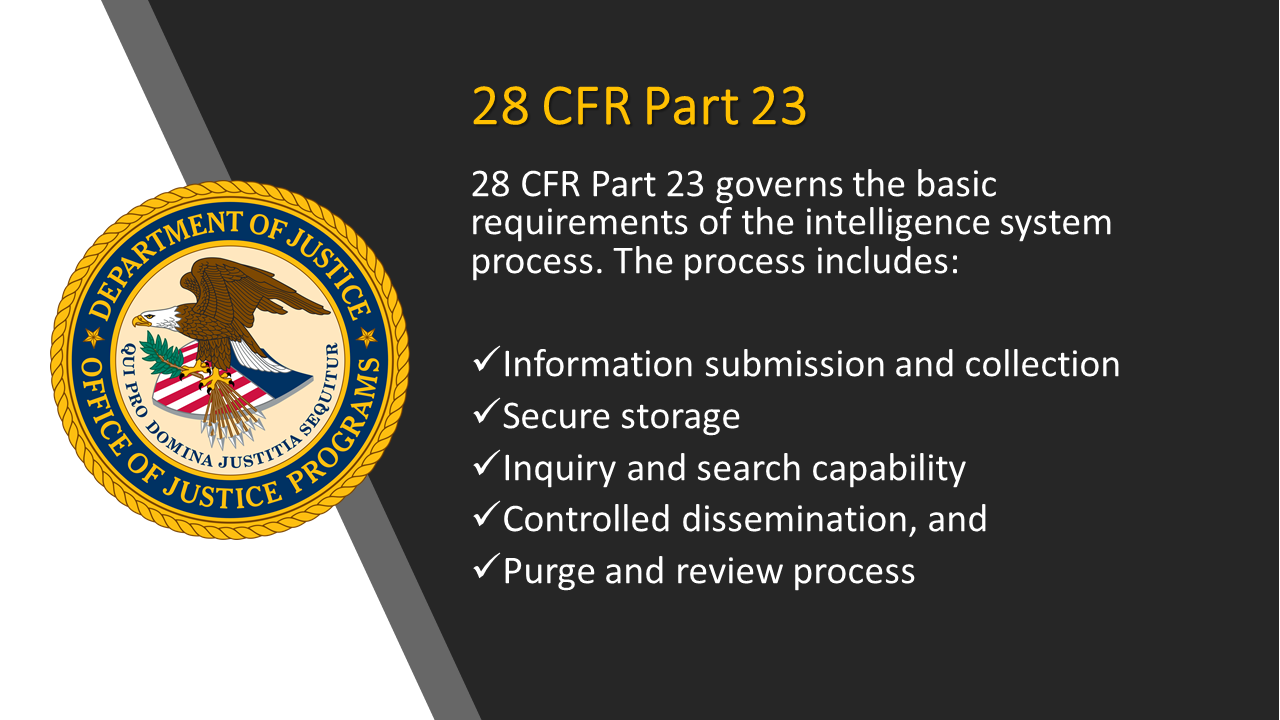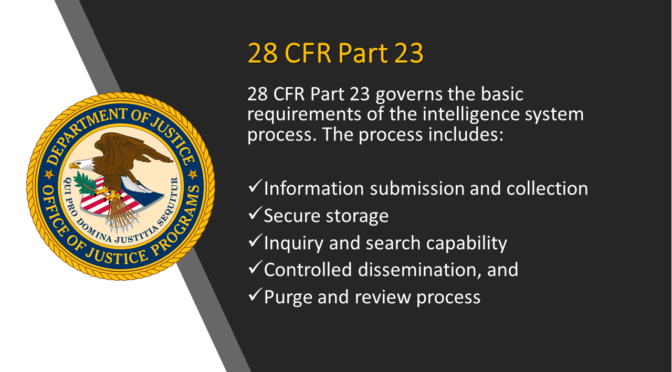Criminal intelligence analysts provide a key element of effective law enforcement, at both the tactical and strategic levels. Analysts study information related to suspects, trends, known criminals, and more. Through a process of gathering evaluating this information, trained intelligence analysts identify associations across various illegal activities over many locations.
 Government decisions and policies are heavily influenced by the insights provided by the criminal intelligence analyst, and police investigations use the intelligence in support of their missions. To that end, the main functions of criminal intelligence analysts include:
Government decisions and policies are heavily influenced by the insights provided by the criminal intelligence analyst, and police investigations use the intelligence in support of their missions. To that end, the main functions of criminal intelligence analysts include:
- Supporting law enforcement activities and large-scale investigations
- Providing an ongoing analysis of potential threats to public safety
- Helping senior officials and policy makers to deal with ever-evolving challenges and uncertainty
There are both tactical and strategic elements to the role of the criminal intelligence analyst. These categories differ with respect to the minutia of details, and the ‘customer’ or end-user of the intelligence.
A. Tactical Criminal Intelligence
Criminal intelligence of a tactical nature attempts to achieve a specific outcome related to law enforcement. Perhaps a disruption of organized criminal groups, a search warrant, seizure of assets, or an arrest.
Tactical criminal intelligence includes:
- The identification of potential connections between people, places, and other entities of interest… and their potential involvement in unlawful activities;
- Recognizing and reporting important gaps in intelligence data;
- Designing and creating detailed dossiers of suspected or confirmed criminals.
 B. Strategic Criminal Intelligence
B. Strategic Criminal Intelligence
Strategic analysis of criminal intelligence is expected to continuously educate policy makers and senior officials about current and evolving criminal activities and patterns. The benefits of strategic analysis tend to be realized over a longer period of time than does tactical analysis.
Emerging criminal trends and activities sit at the core of strategic intelligence analysis. The intelligence can provide advanced warning of potential threats, and can provide law enforcement officials with the information required to prepare their agencies for emerging illegal actions.
Strategic criminal intelligence analysis includes the recognition and documentation of:
- Evolving trends and patterns of illegal activities
- Developing threats
- Modus operandi
- The possible effect of demographics, technologies, and evolving socio-economic factors on criminal activities
 D. Abuse and Misuse of Criminal Intelligence
D. Abuse and Misuse of Criminal Intelligence
The misuse and/or improper storage and unauthorized access to sensitive criminal intelligence data has always been a concern of civil liberty advocates, and has recently been brought to light again with stories regarding misuse of California’s CalGang database. Given the diverse and growing requirements of criminal intelligence management, certain best-practices and policies have evolved in order to help law enforcement agencies collect, store, and disseminate this important criminal intelligence without invading individual rights to privacy.
E. Best Practices for Criminal Intelligence Management
 Specifically, 28 CFR Part 23 is a federal regulation that provides guidance to law enforcement agencies on the standards for implementing and operating federally funded criminal intelligence systems that cross jurisdictions. The protection of individual constitutional rights and civil liberties sits at the core of 28 CFR Part 23. Every American, of course, is afforded a reasonable expectation of privacy. The guidelines outline specific methods to gather, store, disseminate, review, and purge criminal intelligence data.
Specifically, 28 CFR Part 23 is a federal regulation that provides guidance to law enforcement agencies on the standards for implementing and operating federally funded criminal intelligence systems that cross jurisdictions. The protection of individual constitutional rights and civil liberties sits at the core of 28 CFR Part 23. Every American, of course, is afforded a reasonable expectation of privacy. The guidelines outline specific methods to gather, store, disseminate, review, and purge criminal intelligence data.
Recommending the use of these guidelines is The National Criminal Intelligence Sharing Plan (NCISP). NCISP suggests that the regulations ensure that the operations of a criminal intelligence system protect the rights and privacy of individuals and organizations. Importantly, The NCISP suggests that criminal intelligence groups adhere to 28 CFR Part 23, irrespective of whether or not the system was implemented using federal funds and grants.
The criminal intelligence guidelines prescribed by 28 CFR Part 23 have been identified as the minimal policies and rules for sharing data across law enforcement agencies.

The best practices prescribed within the regulation include specific guidelines related to:
- Proper procedures for querying, reviewing, sharing, validating, and purging of criminal intelligence data.
- Multi-jurisdictional memorandums and participation agreements (if applicable).
- The gathering and submission of criminal intelligence information.
- The definition of key criminal intelligence terminology, including ‘the right to know’ and ‘the need to know’.
- The specific activities that may or may not be maintained within the criminal intelligence system.
- Individual rights to access the criminal intelligence systems.
- Security requirements including the auditing and inspection of data.
F. An Excellent Solution
 IntelNexus™ from software developer Crime Tech Solutions is an affordable, yet powerful criminal intelligence management system that complies with the regulations and best practices set forth in 28 CFR Part 23. Whether or not an agency (or agencies) absolutely require compliance to 28 CFR Part 23, the software lays out a framework and enforces the principles that should be incorporated into the criminal intelligence database. IntelNexus offers the foundation for gathering, storing, maintaining, sharing, authenticating, and purging criminal intelligence while ensuring the privacy and civil rights afforded to us all.
IntelNexus™ from software developer Crime Tech Solutions is an affordable, yet powerful criminal intelligence management system that complies with the regulations and best practices set forth in 28 CFR Part 23. Whether or not an agency (or agencies) absolutely require compliance to 28 CFR Part 23, the software lays out a framework and enforces the principles that should be incorporated into the criminal intelligence database. IntelNexus offers the foundation for gathering, storing, maintaining, sharing, authenticating, and purging criminal intelligence while ensuring the privacy and civil rights afforded to us all.
The company also develops the popular Case Closed™ investigation case management software, and provides a suite of advanced crime analytics and link analysis software.

 (j) A project shall notify the grantor agency prior to initiation of formal information exchange procedures with any Federal, State, regional, or other information systems not indicated in the grant documents as initially approved at time of award.
(j) A project shall notify the grantor agency prior to initiation of formal information exchange procedures with any Federal, State, regional, or other information systems not indicated in the grant documents as initially approved at time of award. 5 Funding guidelines.
5 Funding guidelines.


 Since its introduction nearly a decade ago, big data in the form of analytics has helped police agencies all over the world enhance decision making, improve strategies to combat crime, and ultimately solve—and prevent—more crimes. But while the benefits of mining and critically analyzing huge amounts of data are being realized in other developed countries from the United Kingdom to Canada to New Zealand, U.S. law enforcement agencies have generally been slower to jump on the bandwagon.
Since its introduction nearly a decade ago, big data in the form of analytics has helped police agencies all over the world enhance decision making, improve strategies to combat crime, and ultimately solve—and prevent—more crimes. But while the benefits of mining and critically analyzing huge amounts of data are being realized in other developed countries from the United Kingdom to Canada to New Zealand, U.S. law enforcement agencies have generally been slower to jump on the bandwagon. All of these factors have contributed to slowing the adoption of analytics by U.S. police agencies. They are also complicated by perhaps the most intangible impediment: fear of technology. Whether they like to admit it or not, some law enforcement leaders are more comfortable taking an “old school” approach to police work. They prefer business as usual, which means feet on the street and files stacked on their detectives’ desks, not sleek, state-of-the-art technology.
All of these factors have contributed to slowing the adoption of analytics by U.S. police agencies. They are also complicated by perhaps the most intangible impediment: fear of technology. Whether they like to admit it or not, some law enforcement leaders are more comfortable taking an “old school” approach to police work. They prefer business as usual, which means feet on the street and files stacked on their detectives’ desks, not sleek, state-of-the-art technology. The public is also demanding increased police effectiveness and efficiency. Responding to that pressure, police chiefs are recognizing that big data solutions can have a huge impact on reducing the number of man-hours it takes to sift through mountains of data in order to solve crimes. This is particularly important as law enforcement finds itself confronting not only the standard array of home break-ins, car thefts, and the like, but also the threat of “lone wolf” terrorist attacks, cybercrime, and highly sophisticated international trafficking rings.
The public is also demanding increased police effectiveness and efficiency. Responding to that pressure, police chiefs are recognizing that big data solutions can have a huge impact on reducing the number of man-hours it takes to sift through mountains of data in order to solve crimes. This is particularly important as law enforcement finds itself confronting not only the standard array of home break-ins, car thefts, and the like, but also the threat of “lone wolf” terrorist attacks, cybercrime, and highly sophisticated international trafficking rings. The growing use of cloud computing plays a role in this equation. Storing data in the cloud is becoming accepted as safe and secure, bringing with it economic advantages and removing the need for departments to provide highly specialized IT staff and infrastructure previously required to support analytical solutions.
The growing use of cloud computing plays a role in this equation. Storing data in the cloud is becoming accepted as safe and secure, bringing with it economic advantages and removing the need for departments to provide highly specialized IT staff and infrastructure previously required to support analytical solutions.
 Mr. Konczal is a seasoned start-up and marketing expert with over 30 years of diversified business management, marketing and start-up experience in information technology and consumer goods. Additionally, Konczal has over two decades of Public Safety service as a police officer, Deputy Sheriff and Special Agent.
Mr. Konczal is a seasoned start-up and marketing expert with over 30 years of diversified business management, marketing and start-up experience in information technology and consumer goods. Additionally, Konczal has over two decades of Public Safety service as a police officer, Deputy Sheriff and Special Agent. A recent report questions how some police departments are using data to forecast future crimes.
A recent report questions how some police departments are using data to forecast future crimes. How police departments nationwide utilize crime statistics and the software available to patrol officers monitoring incidents has evolved a lot in the past couple decades, Sgt. Tracy Barton with the St. Joseph Police Department said. Barton started as a patrol officer 20 years ago. He said having software like police have today would have been useful.
How police departments nationwide utilize crime statistics and the software available to patrol officers monitoring incidents has evolved a lot in the past couple decades, Sgt. Tracy Barton with the St. Joseph Police Department said. Barton started as a patrol officer 20 years ago. He said having software like police have today would have been useful.
 ryant worked with the Shawnee, Kansas, Police Department on research that looked at what he calls “smart policing.” In his research and in other work he has read, Bryant said it’s important for police to have a high visibility in crime hot spots, for officers to make connections with the public and for them to avoid staying in crime hot spots for extended periods of time.
ryant worked with the Shawnee, Kansas, Police Department on research that looked at what he calls “smart policing.” In his research and in other work he has read, Bryant said it’s important for police to have a high visibility in crime hot spots, for officers to make connections with the public and for them to avoid staying in crime hot spots for extended periods of time.